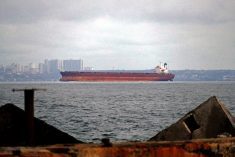CNS Canada — A downtrend in ocean freight rates shows no sign of letting up, as the Baltic Dry Index again hit fresh historic lows.
The Baltic Dry Index (BDI) was quoted at 445 points on Thursday, marking a new low since records began in 1985. The index was trading above 1,200 as recently as the beginning of August, but fell below 500 for the first time ever on Nov. 20. It had shown some stability in the 470 area over the past three weeks, before Thursday’s drop to new lows.
Read Also

U.S. grains: Soybeans hit six-week low as Brazilian harvest looms; corn, wheat sag
Chicago | Reuters – Chicago soybean futures fell to six-week lows on Friday as worries about slowing export demand for…
The BDI, compiled daily by the London-based Baltic Exchange, provides an assessment of the price of moving major raw materials by sea, including grain.
An overcapacity of ships, the slowdown in Chinese demand for building materials, weakness in crude oil and declining commodity prices have all been cited as contributing factors to the lower freight rates, according to freight analysts.
In a note to investors, financial services company Stifel Nicolaus recommended investors “stay away from dry bulk” and cautioned that a recovery in the sector likely won’t take place in 2016, with 2017 also “in question.”
Meanwhile, the Shanghai International Shipping Institute (SISI) reported the low freight rates and poor demand will likely lead to a large amount of bankruptcies in the sector, with 60 per cent of dry bulk shipping firms surveyed said to be struggling with long-term losses.
“The market is extremely depressed and these conditions are likely to continue in 2016, exacerbating dry bulk firms’ losses, increasing costs and creating obstacles to obtaining financing. This will kick-start a wave of bankruptcies,” SISI said in a report released Tuesday.
As far as Canadian grain and oilseed exports are concerned, the lower freight rates even the playing field in some cases by lessening the importance of shipping costs in the final price to the buyer.
For example, while Australia will always be closer to China than Vancouver, lower freight rates reduce the importance of shipping costs in the final price.
— Phil Franz-Warkentin writes for Commodity News Service Canada, a Winnipeg company specializing in grain and commodity market reporting.
















